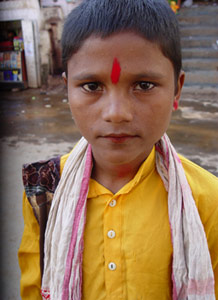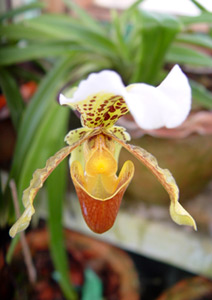Cherrapunji Cascades
But then as Shakespeare, the bard, said, “What’s in a name?” Call it whatever you want, but this place, perched between 3,000-4,607 feet above sea level, would have carelessly sat next to the Meghalaya plateau and waited for the moisture-laden southwest monsoon to lash it. That is why it doesn’t rain in this area -- it actually pours. Imagine 1,040 millimeters of rain in 24 hours and 9,300 mm of rainfall in a month! Believe the meteorologists when they say that the epicenter has moved a few kilometers away to Mawsynram, but Cherrapunji is like an old flame, still flaunting its tag and its beauty.

It was this wettest place that I was driving to on a nippy November morning. We had barely gone a few miles when I remembered my umbrella, which I had forgotten to take. “Don’t bother, it won’t rain,” the guide assured. But I did not want to see a parched Cherrapunji; I wanted to get drenched.
The drive from Shillong made us feel more like we were walking through clouds than being mere mortals in a small car, braving the cold and terribly bumpy road. Anywhere the eyes went, there was fog, and the hills were so green that it felt as if the gods had dropped all other hues from their palette when creating Meghalaya. Providing stark contrast were the megaliths’ brown pieces of unadorned rocks standing upright on hilltops, on flat land and in the courtyard of houses. They were innumerable, these stone memorials standing for hundreds of years in honor of ancestors. No names were etched on them, no drawings, no epitaphs, just bare rocks and memories.
As we drove into the village, I saw red ribbon-like strips hanging on a clothesline next to jumpers and cardigans. I peered hard and realized they were slices of meat drying in the sun. Never before had I seen meat on a clothesline! Further down the road, I noticed signboards advertising “Genuine Orange Flower Honey,” and the guide informed us that Cherrapunji is famous for its oranges and honey made from its flowers.
At the first viewpoint inside Cherrapunji, I heard rainwater thundering down hills, but what I saw was only a trickle. I lay flat on a rock, looked up at the sky and the meandering clouds and invoked the gods. “Just a drizzle, god. Just a drizzle.” But it was not meant to be. When it rains in Cherrapunji, you can actually see a crowd of waterfalls, each more beautiful, more bountiful and more raucous than the other.
I waited for the drizzle and then drove on, this time to Thangkharang Park, from where I could see bare outlines of Bangladesh. It was serene and lush, but the park is known more for its greenhouse than anything else. Only four people are allowed inside the greenhouse at a time, and for good reason. It houses rare orchids and the utterly gorgeous insectivorous pitcher plant. The lady’s slipper orchid gets its name from, well, a lady’s slipper. Its labellum looks so delicate that you want to slip your feet in. And, yes, the pitcher plant. Forget everything else and look at the plant that traps insects inside its elegant frame. Some of the pitchers are so big that they could swallow a sparrow.
Not too far from the park was Mawsmai Cave, the only fully lit cave in the state. The walk up the concrete steps can leave you breathless, but the cave is gorgeous. The ground beneath my feet was wet, and I scraped my wrist trying to squeeze through the darkness. I slipped and bruised my knee, but once inside, I sat and gazed at this miracle of nature. When you walk out and your stomach growls with hunger, relish the rice-dal-curry fare at the kiosk. For fewer than US¢50, it is quite a mouthful, and the chutneys and the chilies are added in for free.
If the orchids are elegant and rare and the caves ancient and stunning, there’s no way to describe the living root bridges that are not found anywhere else in the world. It is the perfect example of bio-engineering, dating back to more than 200 years. A short distance from Cherrapunji are bridges made by pulling and stretching the roots of a plant -- in this case, the rubber plant -- and planting them on the other side of the stream. Over the years, these roots grew and morphed into bridges that have lived for hundreds of years. There’s  even a double-decker living root bridge!
even a double-decker living root bridge!
Our last destination was Noh KaLikai Falls, which takes its name from a widow whose second husband killed and cooked the widow’s daughter for dinner. It is here where the water falls into what looks like a pool of jade. It is here where I saw a pile of cinnamon bark, so flavorful and brown, that I wanted to buy all of it. The stack would have cost a fortune, so I settled for small packets.
It was dark when we left Cherrapunji, and several miles away, I heard a rumble. Did it rain there after I left? I don’t know. That day, the village of Cherrapunji stayed completely parched, and there were buckets lined up at the village water tap. I guess that even the world’s wettest place has its mundane hassles – but that’s another story.
Tips:
Suggested Reading:
Under a Cloud by John K. Binoo
How/when to go:
Take a cab from Shillong, which is 56 km away. If you want to see Cherrapunji in all its grandeur, go between July and September to experience the rainiest season.
What to bring:
Carry a light jacket or a shawl, as the difference in the day and night temperatures can fool you.
Food:
There are several kiosks that sell tea, potato chips and food. You won’t find any fancy places to eat. Carry food if you are finicky.
What to see:
Noh KaLikai Falls
Noh Sngi Thiang Falls
Dain Thlen Falls
Kynrem Falls
Mawmluh Cave
Mawsmai Cave
David Scott Memorial
Khoh Ramhah
Ka Kpep Syiem Sohra, a cremation ground
Thangkharang Park
Living Root Bridges
Mawsynram

